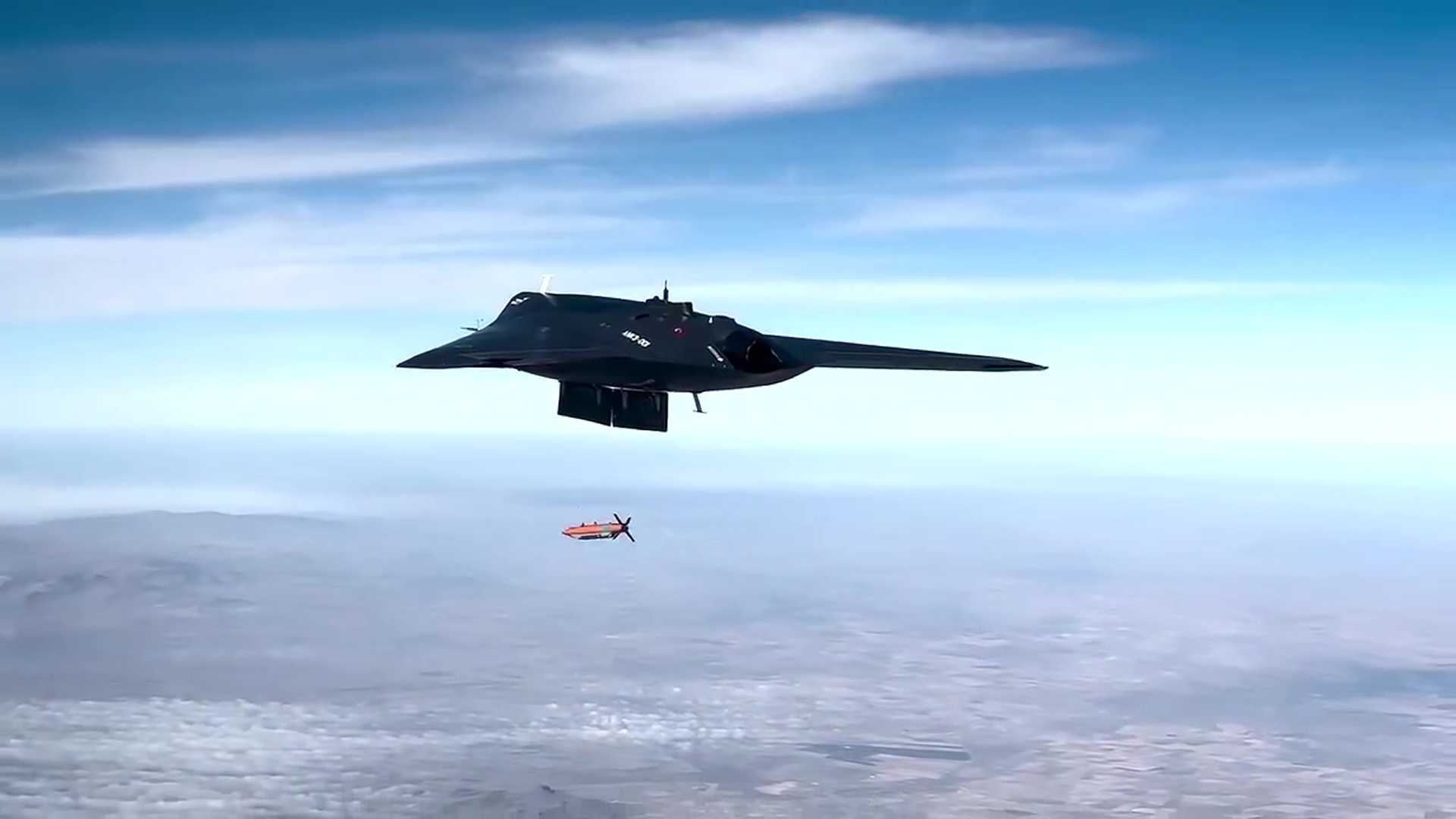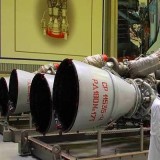Turkish Air Force’s Anka-3 stealth drone completes first internal munition test to expand strike capabilities

{loadposition bannertop}
{loadposition sidebarpub}
On January 13, 2025, Turkish Aerospace Industries (TAI) reported that the Anka-3 unmanned combat aerial vehicle (UCAV) successfully conducted its first internal payload munition release. The test involved deploying Aselsan’s domestically-produced Tolun guided munition at an altitude of 20,000 feet and a speed of 180 knots. This marked a significant technical demonstration of the platform’s internal weapons bay functionality and operational capability.Follow Army Recognition on Google News at this link
Powered by a single AI-322 engine, the Turkish Anka-3 stealth drone, which carries up to 1,200 kilograms of munitions, can reach a maximum speed of 450 knots and operate at altitudes up to 40,000 feet. (Picture source: TAI)
The Anka-3, developed under TAI’s Project MIUS (Combat Unmanned Aircraft System), is a stealth UCAV designed for multi-role missions, including reconnaissance, surveillance, and precision strikes. It features a flying-wing design aimed at reducing its radar cross-section, making it suitable for operations in contested airspaces. Powered by a single AI-322 engine, the drone can reach a maximum speed of 450 knots and operate at altitudes up to 40,000 feet. It has a maximum takeoff weight of 6.5 tons and can carry up to 1,200 kilograms of munitions, such as SOM-J cruise missiles, small-diameter bombs, and Tolun guided bombs.
The Tolun munition, designed and manufactured by Aselsan, uses GPS/INS guidance for precision targeting with a circular error probability of less than 10 meters. It can penetrate one meter of reinforced concrete when released from 30 nautical miles away. With folded wings for extended range, the munition can reach distances of up to 55 nautical miles at higher altitudes. Tolun has been tested under electronic warfare conditions, maintaining precision under GNSS jamming. During prior tests, it demonstrated the capability to engage multiple targets simultaneously, including a test with four munitions hitting separate targets when deployed from an F-16. Variants such as the Tolun-IIR add imaging infrared guidance, enabling engagement of moving targets and man-in-the-loop control.
The Anka-3 program has reached several milestones. It made its maiden flight on December 28, 2023, and completed its first live-fire test on September 20, 2024. In this test, conducted with Aselsan and Roketsan, the drone struck its target using an AF500 electro-optic camera and Teber-82 guidance kit. On October 30, 2024, the Anka-3 became the first UCAV to be controlled by another aircraft, demonstrating interoperability for potential “loyal wingman” missions with manned platforms like the KAAN fighter jet.
The Turkish Anka-3, a stealth UCAV designed for multi-role missions, including reconnaissance, surveillance, and precision strikes, features a flying-wing design aimed at reducing its radar cross-section, making it suitable for operations in contested airspaces. (Picture source: TAI)
Future upgrades to the Anka-3 include plans to equip it with twin TEI TF10000 turbofan engines. These engines, under development as domestic alternatives to the General Electric F110, are expected to provide supersonic capability, supporting operations alongside supersonic manned fighters. Current testing has focused on optimizing the platform’s stealth design, payload integration, and operational range.
The Anka-3 complements other Turkish platforms, including Baykar’s Akıncı and Kızılelma UCAVs. Akıncı, in particular, has integrated various munitions, including Tolun and Tolun-IIR, for precision strike capabilities. Aselsan’s development of these munitions supports Türkiye’s strategy of advancing indigenous defense capabilities while reducing dependence on foreign suppliers. Azerbaijan, for example, has ordered Tolun bombs for use with its Akıncı UCAVs, with deliveries scheduled for 2025.
Aselsan’s Tolun has been exported previously, including a 2023 order worth $36 million for an undisclosed customer. During tests, Tolun demonstrated a range of up to 100 kilometers when released from high altitudes. This munition family has drawn comparisons to the U.S. GBU-39, which has faced challenges in GPS-jammed environments, whereas Tolun has maintained its targeting precision under similar conditions.
The Turkish Air Force is expected to receive its first operational Anka-3 in early 2025. The UCAV is currently undergoing prototype testing, with two prototypes built to date. Production is expected to continue, with multiple units planned for delivery by 2028. This program is part of Türkiye’s broader efforts to expand its fleet of unmanned systems and strengthen its position in the global drone market. Türkiye’s unmanned aerial systems, including Anka-3 and its munitions, have attracted interest from international customers, further demonstrating their utility in modern combat scenarios.
In summary, the Anka-3 represents a step forward in Türkiye’s development of stealth UCAVs. Its capabilities, such as internal payload deployment, multi-role functionality, and potential for future upgrades, align with the country’s focus on expanding its indigenous defense industry. Ongoing developments and integrations are expected to enhance operational flexibility while contributing to Türkiye’s efforts to strengthen its domestic defense production capabilities.
The Tolun munition, designed and manufactured by Aselsan, uses GPS/INS guidance for precision targeting with a circular error probability of less than 10 meters, and can penetrate one meter of reinforced concrete. (Picture source: Army Recognition)

{loadposition bannertop}
{loadposition sidebarpub}
On January 13, 2025, Turkish Aerospace Industries (TAI) reported that the Anka-3 unmanned combat aerial vehicle (UCAV) successfully conducted its first internal payload munition release. The test involved deploying Aselsan’s domestically-produced Tolun guided munition at an altitude of 20,000 feet and a speed of 180 knots. This marked a significant technical demonstration of the platform’s internal weapons bay functionality and operational capability.
Follow Army Recognition on Google News at this link
Powered by a single AI-322 engine, the Turkish Anka-3 stealth drone, which carries up to 1,200 kilograms of munitions, can reach a maximum speed of 450 knots and operate at altitudes up to 40,000 feet. (Picture source: TAI)
The Anka-3, developed under TAI’s Project MIUS (Combat Unmanned Aircraft System), is a stealth UCAV designed for multi-role missions, including reconnaissance, surveillance, and precision strikes. It features a flying-wing design aimed at reducing its radar cross-section, making it suitable for operations in contested airspaces. Powered by a single AI-322 engine, the drone can reach a maximum speed of 450 knots and operate at altitudes up to 40,000 feet. It has a maximum takeoff weight of 6.5 tons and can carry up to 1,200 kilograms of munitions, such as SOM-J cruise missiles, small-diameter bombs, and Tolun guided bombs.
The Tolun munition, designed and manufactured by Aselsan, uses GPS/INS guidance for precision targeting with a circular error probability of less than 10 meters. It can penetrate one meter of reinforced concrete when released from 30 nautical miles away. With folded wings for extended range, the munition can reach distances of up to 55 nautical miles at higher altitudes. Tolun has been tested under electronic warfare conditions, maintaining precision under GNSS jamming. During prior tests, it demonstrated the capability to engage multiple targets simultaneously, including a test with four munitions hitting separate targets when deployed from an F-16. Variants such as the Tolun-IIR add imaging infrared guidance, enabling engagement of moving targets and man-in-the-loop control.
The Anka-3 program has reached several milestones. It made its maiden flight on December 28, 2023, and completed its first live-fire test on September 20, 2024. In this test, conducted with Aselsan and Roketsan, the drone struck its target using an AF500 electro-optic camera and Teber-82 guidance kit. On October 30, 2024, the Anka-3 became the first UCAV to be controlled by another aircraft, demonstrating interoperability for potential “loyal wingman” missions with manned platforms like the KAAN fighter jet.

The Turkish Anka-3, a stealth UCAV designed for multi-role missions, including reconnaissance, surveillance, and precision strikes, features a flying-wing design aimed at reducing its radar cross-section, making it suitable for operations in contested airspaces. (Picture source: TAI)
Future upgrades to the Anka-3 include plans to equip it with twin TEI TF10000 turbofan engines. These engines, under development as domestic alternatives to the General Electric F110, are expected to provide supersonic capability, supporting operations alongside supersonic manned fighters. Current testing has focused on optimizing the platform’s stealth design, payload integration, and operational range.
The Anka-3 complements other Turkish platforms, including Baykar’s Akıncı and Kızılelma UCAVs. Akıncı, in particular, has integrated various munitions, including Tolun and Tolun-IIR, for precision strike capabilities. Aselsan’s development of these munitions supports Türkiye’s strategy of advancing indigenous defense capabilities while reducing dependence on foreign suppliers. Azerbaijan, for example, has ordered Tolun bombs for use with its Akıncı UCAVs, with deliveries scheduled for 2025.
Aselsan’s Tolun has been exported previously, including a 2023 order worth $36 million for an undisclosed customer. During tests, Tolun demonstrated a range of up to 100 kilometers when released from high altitudes. This munition family has drawn comparisons to the U.S. GBU-39, which has faced challenges in GPS-jammed environments, whereas Tolun has maintained its targeting precision under similar conditions.
The Turkish Air Force is expected to receive its first operational Anka-3 in early 2025. The UCAV is currently undergoing prototype testing, with two prototypes built to date. Production is expected to continue, with multiple units planned for delivery by 2028. This program is part of Türkiye’s broader efforts to expand its fleet of unmanned systems and strengthen its position in the global drone market. Türkiye’s unmanned aerial systems, including Anka-3 and its munitions, have attracted interest from international customers, further demonstrating their utility in modern combat scenarios.
In summary, the Anka-3 represents a step forward in Türkiye’s development of stealth UCAVs. Its capabilities, such as internal payload deployment, multi-role functionality, and potential for future upgrades, align with the country’s focus on expanding its indigenous defense industry. Ongoing developments and integrations are expected to enhance operational flexibility while contributing to Türkiye’s efforts to strengthen its domestic defense production capabilities.

The Tolun munition, designed and manufactured by Aselsan, uses GPS/INS guidance for precision targeting with a circular error probability of less than 10 meters, and can penetrate one meter of reinforced concrete. (Picture source: Army Recognition)




